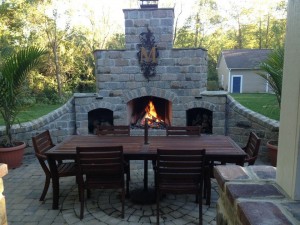
You feel the chill in the air lately, don’t you? Mornings and evenings here in the Kansas City area are definitely starting to feel like Fall. And here in the Midwest, we know that when the leaves start to turn and sweaters become part of our everyday wardrobe, winter—and freezing temperatures—can’t be far behind.
But before we think too much about what’s to come, let’s think about the coziness of this season. As the temps start to dip, we can spend more time comfortably outdoors. We can fire up the bonfire or grill dinner without sweating through our shirts. And we can settle in on the deck for a drink as we enjoy the company of family.
If your idea of a perfect outdoor space includes a outdoor fireplace, keep reading! You’ll learn a bit more about the difference between natural and gas fireplaces and things you should consider before taking the plunge.
What Is a Natural Outdoor Fireplace?
A natural fireplace is one that burns natural material—i.e., wood—for fuel. Constructed from a wide variety of materials including metal, stone, and brick, a natural fireplace can be an interesting way to add a fire element to your landscape.
Like other fire features, natural fireplaces require safety precautions. An obvious precaution is to ensure that the fireplace is not near trees or hanging limbs, or overhead electrical wires. Another precaution is to use the right fuel to stoke the fire, meaning wood meant specifically for burning. Never use trash, plastic, or other materials. Also, work closely with your landscape architect to ensure that embers from the fire move up, rather than out.
What Is a Gas Outdoor Fireplace?
A gas fireplace is one that relies on gas as fuel. Think of this as the difference between a charcoal grill and a propane grill–a gas fireplace is like the latter. It’s similar to a natural fireplace in that it can be made from any number of materials. But unlike a natural fireplace, you have additional safety considerations unique to gas. Making sure there’s proper clearance between gas lines and structures is one. Ensuring proper ventilation is another.
Outdoor Fireplace Safety Considerations
No matter your choice of fuel source, there are things you must consider before building any outdoor fireplace. Location is one: a fireplace needs to be built an appropriate distance from other outdoor structures, like your home and garage. It also needs to be placed in a way that keeps the area around it safe. For example, if you have many trees, this might affect where you put an outdoor fireplace.
It’s also important to check with your town or city to make sure local ordinances allow the building of outdoor fireplaces. If they do, there might be additional parameters that you’ll have to be aware of before you start building. The same is true of homeowners associations. It’s best to make sure you comply with all applicable rules right from the start.
The Advantages of an Outdoor Fireplace
A 2018 survey conducted by Houzz found that 51% of homeowners spent more time outdoors after completing improvement projects. It also found that the addition of outdoor heating sources like fire pits and fireplaces encouraged people to entertain outdoors year-round.
Studies like this confirm what we already know: \when we create an outdoor space that makes us happy, we’ll do two things. We will spend more time outdoors, and we’ll invite others to join us. Adding an outdoor fireplace to your space might be the perfect way to ensure that even when the weather turns colder, you can still enjoy the outdoors with your family and friends.
No matter what type of outdoor fireplace you think will work best for you, it’s always a good idea to discuss your plans, budget, and timeline with an experienced landscaper. We’re here and eager to help when you’re ready.


